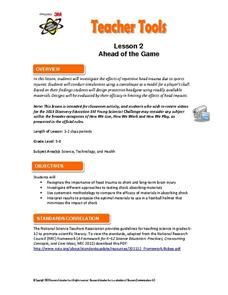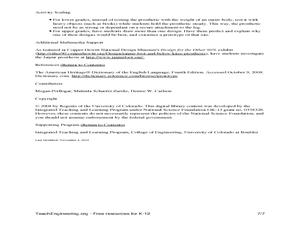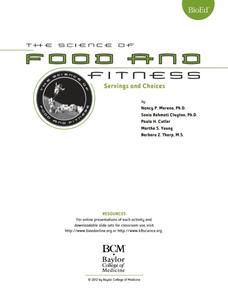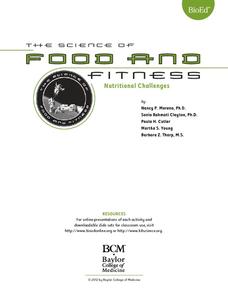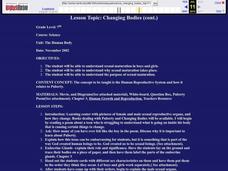Baylor College
Lungometer
Life science learners construct lung-o-meters from gallon-sized milk jugs and then measure their lung capacities. For older learners, have them graph the vital lung capacities of each person in the class. Cross-curricular pieces are...
Baylor College
Heart Rate and Exercise
Teach your exercise enthusiasts to read their pulse rate at the radial artery and multiply by four to calculate beats per minute. Learners perform a variety of activities, recording their heart rates after one minute of each. Though...
Baylor College
Your Energy Needs (BMR)
How many Calories one needs on a daily basis is dependent on a number of factors including gender, height, and activity level. In the third of seven lessons about energy and food, young nutritionists calculate the number of Calories...
Baylor College
Energy Sources
Take the concept of burning calories to a more literal level in the second of seven lessons about energy in the realm of food and fitness. Using simple materials, groups will burn breakfast cereal and a pecan to see which one gives off...
Baylor College
Heart and Lungs
With a partner, youngsters measure their pulse and breathing rates, both at rest and after running in place for a minute. While this activity is not novel, the lesson plan includes a large-scale classroom graphing activity and other...
Curated OER
Natural resource Race
Second graders answer true or false questions about natural resources. They stand on lines opposite each other and hop toward the middle if they answered the question correctly.
Discovery Education
Ahead of the Game
According to the movie Wildcats, "It's the sport of kings, better than diamond rings, football!" It is also, however, the sport of severe concussions and ongoing blows to the head. In order to keep our Seahawks soaring and Broncos...
Baylor College
Serving Sizes
Are serving sizes for different foods always appropriate for what you need? In this hands-on activity, learners work in groups to estimate what one serving size of various foods are, and then evaluate their hypotheses by measuring...
Baylor College
Your Nutrition Needs
It takes some work to ensure you have a balanced diet, but once you know the types of foods that are good for you, it becomes second nature. In the sixth of seven lessons about energy and nutrition, learners create a healthy eating plan...
Lunch Lab
Exercise
This is the perfect resource for helping youngsters understand the importance of physical activity in their daily lives. The lesson and its worksheets focus on brainstorming a variety of fitness activities, such as games you can...
BioEd Online
Serving Sizes
When it comes to eating a balanced diet, portion control is paramount, but what is the difference between the serving size on the nutrition facts label and a portion as determined by the USDA? In a comprehensive look at portion control,...
Baylor College
Energy for Life (Energy from Food)
Energy comes in many forms, but how do living things get the energy they need to survive and thrive? In a simple, controlled experiment with yeast, water, and sugar, groups make observations about how yeast reacts with water alone, then...
Curated OER
Prosthetic Party
Students examine human anatomy by creating a prosthetic limb. In this medical engineering lesson, students view numerous images of prosthetics used in science today and define several medical terms associated with prosthetics....
Baylor College
Servings and Choices
An important part of balancing caloric intake to energy expenditure is knowing how many Calories you are consuming. In the fifth of a seven-lesson series on food and energy, learners estimate their daily caloric intake, then use a...
BioEd Online
Nutritional Challenges
Eating healthy can be a challenge, especially for people with special dietary needs. After learning about standard nutritional needs for adults, learners take on the role of a dietician and work together to create a menu for one of the...
Curated OER
Creature Tag
First graders play a version of tag. They come out of the designated safe area when the teacher calls out a signal. They move to a new safe area when another signal is called out. A tagger is performing the same action while trying to...
Curated OER
Do These Properties Matter?
Third graders rotate between three property stations, the solid station, the gas station, and the liquid station. They experiment with each activity until the teacher gives the signal to change.
Curated OER
Water Speedway
Fourth graders observe changes in matter caused by the addition of heat. They participate in a physical education activity where they deal with science concepts. They have a knowledge of how particles act in water when heated.
Personal Genetics Education Project
Protecting Athletes with Genetic Conditions: Sickle Cell Trait
Should school and professional teams test athletes for sickle cell trait? Will it protect them by providing knowledge or lead to discrimination by not allowing them to participate in sports? After learning about this genetic disorder,...
Curated OER
Understanding MyPyramid
Fifth graders investigate serving sizes. In this serving size lesson, 5th graders study the food pyramid paying special attention to proper serving sizes of food. Resources are provided.
Curated OER
Winter Survival
Students create a list of the five most important things they need to survive a winter night. For this survival lesson, students work in groups to list things they would need to survive a night outside in winter. Students remove items...
Curated OER
Theatre Lesson Plan- Tableau (part 2)
Students explore tableaux. In this social studies and fine arts cross curriculum lesson, students work in groups of four to create "frozen" stage pictures (tableaux) representing vocabulary and concepts from a "From Farm to You"...
Curated OER
Changing Bodies
Seventh graders investigate the human body by viewing a movie and asking questions. In this sexual maturation lesson, 7th graders identify the ways boys and girls develop into men and women through puberty. Students view a video and take...
Curated OER
Rock, Soil, or Water?
Students participate in an activity in which they identify properties of water, soil and rocks. They work together to identify different types of rocks. They ask questions to complete the instructional activity.






